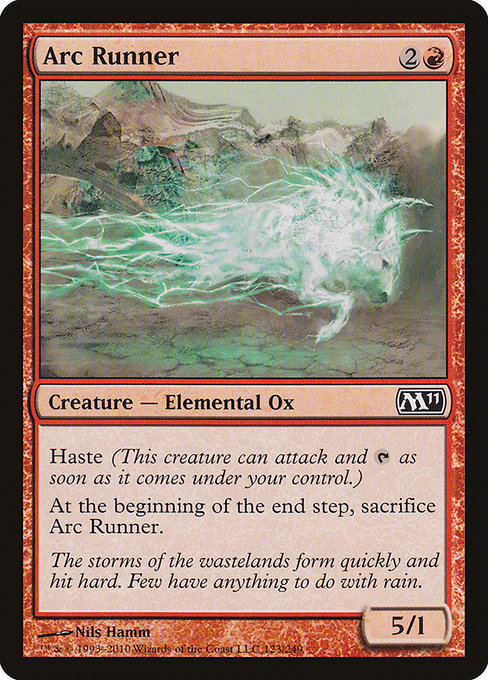
Image courtesy of Scryfall.com
Arc Runner: Market Movements, Price Shifts, and Collector Value
For fans of red aggression and the stubborn charm of older core sets, Arc Runner stands as a microcosm of how MTG card prices drift—driven less by meta power than by nostalgia, print runs, and the slow burn of foil scarcity. This 3-mana red creature from Magic 2011 crashes onto the battlefield with haste, a glorious reminder that raw aggression can sometimes win the race before the clock ticks down. At a first glance, Arc Runner is a straightforward 5/1 haste for {2}{R}, with a self-sacrificing end step, but the market tells a broader story about how players and collectors value speed, risk, and artifact-like finishes in a historically printed core set. 🧙♂️🔥
From a gameplay standpoint, Arc Runner is a classic example of tempo: it can swing immediately, pressuring an opponent before blockers are formed, and then vanish at the end of the turn. The card’s power lies not just in stat lines, but in its ability to turbo-charge a red deck’s early plan. Its endurance in casual circles is echoed in modern formats where red-based strategies still chase fast starts; yet its actual playability in top-tier formats remains limited, which compounds its price dynamics as a collector’s piece rather than a perennial staple in a competitive metagame. The flavor text—“The storms of the wastelands form quickly and hit hard. Few have anything to do with rain.”—gives Arc Runner a rugged, wasteland mystique that resonates with players who love the chaotic beauty of red’s tempo discipline. 🎲⚔️
Today’s price snapshot shows Arc Runner as a modestly budget-friendly card in nonfoil form, with a USD value around $0.10, while its foil counterpart commands a noticeably higher premium at about $1.11. That foil premium isn’t just about sparkly art; it reflects the broader market reality for players who chase build-around potential or who love the tactile shimmer of foil finishes on older cards. The discrepancy also hints at supply constraints: foils from Magic 2011 were never produced in the same volume as modern sets, and many players treat them as small, collectible opportunities rather than everyday gameplay pieces. 💎🔥
Market watchers also consider a card’s long-tail collector appeal beyond standard play. Arc Runner sits in Modern and Legacy legality, which helps keep a baseline demand stream alive, even if it isn’t a marquee modern staple. Its EDHREC ranking sits well outside the upper echelons, indicating it’s not a go-to commander pick for most players, but that doesn’t diminish its charm. In fact, for those who relish a little nostalgia in their cube or casual red decks, Arc Runner offers a satisfying bite—fast, flashy, and fleeting. The numeric realities matter, but the story behind those numbers—Nils Hamm’s illustrated storm-tamed ox, the core-set era vibe, and the tactile thrill of foil—adds a layer of collector value that many players secretly chase. 🎨🧙♂️
“Value isn’t just what a card does on the table; it’s what it represents in a lifetime of collecting—print runs, foil surges, and the memory of a moment when a red ox with wings of fire charged past every shield.”
For those tracking price trends, Arc Runner showcases a few dependable patterns. First, as a common from a core-set release, it benefits from broader printing that stabilizes price in nonfoil form, keeping it accessible for budget players. Second, foils tend to carry the premium you’d expect for older, non-lottery-print-run foils—scarcity combined with demand creates a higher floor on the foil side, even when the nonfoil price remains modest. Third, the card’s status as a punchy, early-game threat with a built-in sacrifice gives it a certain nostalgia-based appeal that persists among players who started collecting around 2010–2011. If you’re exploring the arc of MTG’s fan-driven economy, Arc Runner is a microcosm of how supply, demand, and sentiment interact in the long run. 🧭💎
For collectors who love the confluence of art, rarity, and a bit of chaos, Arc Runner’s story is a reminder that even a single red creature can carry a surprising amount of depth. The card’s design—color identity red, mana cost {2}{R}, and its haste-laden, temporary battlefield presence—echoes a philosophy of urgency that magnetic magnetizes both players and speculators. And if you enjoy connecting your MTG hobby with everyday life—whether you’re gaming, drafting, or even curating a desk setup—there’s a satisfying symmetry in pairing a nostalgic card with a contemporary desk accessory, like the neoprene mouse pad featured below. 🧙♂️🎲
Speaking of desk setups, we’re always on the lookout for ways to blend MTG passion with everyday productivity. If you’re upgrading your workspace, consider pairing a vivid desk pad with a nod to your favorite sets—Arc Runner’s bold red energy can feel like a spark of urgency during a late-night drafting session. And yes, the thrill of a foil Arc Runner can inspire a little extra investment in your collection, much like investing in a coordinating desk accessory can elevate your gaming corner. 🔥🎨
To help you explore more on the market and design side of the MTG universe, check out the cross-promotional feature below and a shelf of five fresh reads from our network. The balance between collecting and content discovery is where the real magic lies. 🧙♂️💫
Neoprene Mouse Pad - Colorful Desk PadMore from our network
- https://crypto-acolytes.xyz/blog/post/how-lost-bitcoin-reshapes-markets-and-wallets/
- https://blog.digital-vault.xyz/blog/post/designing-digital-life-planner-templates-for-productivity/
- https://crypto-acolytes.xyz/blog/post/top-10-best-pc-horror-games-for-spooky-thrills/
- https://blog.digital-vault.xyz/blog/post/how-to-build-high-converting-ecommerce-product-page-templates/
- https://blog.digital-vault.xyz/blog/post/from-limits-to-lore-alchemists-greeting-in-mtg-card-design/